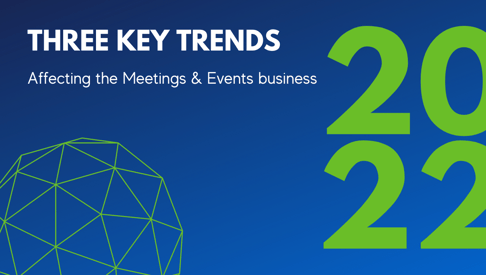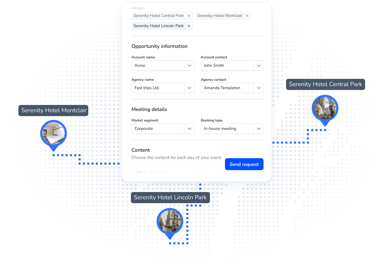
MeetingPackage
To meet the changing business requirements in 2022 you need to make sure you have the technology in place so you can be much more flexible with your Meetings & Events spaces. It’s one thing to say: I understand customers want to book spaces easily. It’s another thing to actually put that into action. Fortunately, software is now being built with this in mind.
Read from below few key findings which will impact Meetings & Events business heavily in the upcoming year.
Customer profile has changed - Casual meeting bookers are here to stay
Professional meeting bookers like travel agents, travel managers, and so on used to be customer segment that did most of the meeting bookings but this has changed. Nowadays, it's your "average Joe/Jane" that search and book meeting rooms in increasing numbers. So how do you reach this new customer profile? The answer is simpler than the execution. All customers are looking for an easy and simple way to configure, price and book meeting services online. Hardly anyone is aware that booking a meeting room is not possible to do online...for the large part of the booking at least. Sure this might been recognised in the industry but for the customer the reality hits hard when they try to find and book a meeting rooms online. Often, they still need to ask availability, price and what the venue has to offer via webform. This really should not be the case in this day and age. Customer demand is increasing for simplicity to buy your services. And it is here to stay, that is just an inevitable fact.
Here are a few of the global trends that are influencing this change:
- increase of bookings completed by "millennials" , who are used to buying and operating in the digital hemisphere. It is just a bad buying experience if you need to ask (and often wait) for detail before getting the information you need to complete the booking. Naturally, this is a customer segment that will only increase in the near future.
- The Covid pandemic has accelerated the change to hybrid working and decreased corporate office spaces. In turn, this has led to increased amount of off-site meetings. People still need to meet for a variety of reasons and webinars are not the right medium and are not an efficient format to handle them e.g. workshops, project meetings, etc.
- Business travel decreased. This one actually was a bit surprising to us. We can see that the amount of local meetings have increased while business travel is on pause. We wondered why and our survey results indicate that "hybrid meetings" were one of the reasons. For example, local sales group book a meeting room and connect via Zoom, Google Meet, etc. with other local sales groups. So rather than "flying in" every sales representative there are cluster of smaller sales meetings that are connected online to each other at the same time to form a "larger" meeting.
Buying behaviour has changed - Events are smaller, more frequent and lead time shortened
As the meeting booker profile has changed so has the buying behaviour. This is only natural but it's good to think about it a bit more thoroughly. "Casual bookers" are by no means comparable to professional bookers. Services like "break out room" or even "packages" are often unknown aspects to a person that has a need to meet at some preferred location. More than 80% of the RFP's or bookings change between the time of booking and the actual event date. The need for extra services is often realised by the "casual meeting booker" after the booking and this presents an operational problem for the venues to solve as well as potential to up-sell services. Whereas, professional meeting bookers have the experience and know-how to already take a majority of these aspects into account at the time of the booking. Therefore, suppliers need to have an understandable value proposition and a clear service offering at the time of the booking already. This takes a lot of frustration away from the sales/buying process and increases customer satisfaction from the very first encounter between the stakeholders.
Making it easy to book meeting and event spaces for the customer is not enough. Our data shows that the booking average value has dropped while the volume has gone up. What this should indicate to a venue operator is to offer more smaller meeting space available with a clear service offering and preferably showing online availability. You as venue operator can get business in quicker and easier while focusing the operational efforts on the more complicated and higher value RFP's. If you can get volume through smaller meetings automatically it's more likely that you can sell the bigger events by focusing human resources to those RFP's. Our data also shows that when venues offer live availability and pricing, casual meeting bookers can make the decision immediately and as a consequence do not request RfP’s from 5 – 10 venues.
Showing availability and possibility to pay online is also increasing importance to venue operators. The lead time between booking (or sending RfP) and the actual event date has drastically decreased. Before the ongoing pandemic the average lead time was about 35 days whereas now it is 8 days! Customers do not have time to wait 24 hours for answers about "availability" or "price" if the meeting is to take place day after tomorrow. If your response is not quick or instant then the potential customers remains on the word potential. Because at that point the customer has chosen another vendor who has replied to their needs quicker. This is why, offering availability, pricing, and possibility to buy the service on the spot is even more crucial than before.
Less staff to cope with the demand
As we all know, the Covid pandemic hit hospitality industry especially hard. A lot of businesses are suffering, people have been made redundant and many have moved away from the industry, and understandably so. This makes it even more harder for the venues to find new talent when the business is recovering. Where to get the employees back? Inevitably, the demand comes first and supply try's to adjust to the demand.
As we talked about the above topics there is an increasing amount of demand for smaller meetings which means more work in the sales department if the sales is done "traditionally". Again, this is an additional indicator that the small M&E sales should be automised digitally so that your reduced operations team can handle the demand when it fully recovers. On top of that, automation should be used in the traditional sales channels when it helps. This does not mean that everything is automised. For example, if your customer sends an email and request for proposal, it would be much easier to send web proposal back to that customer. This eliminates those annoying and time consuming amendments to the attached proposals that you and the customer are sending back-and-forth.
To summarise the above now is the time to start developing your sales strategy for the future. Register your venue from the link below and start optimizing your Meetings & Events service offering for your customers.





